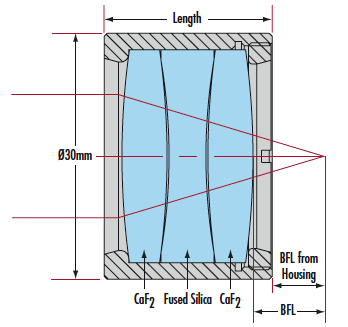
 TECHSPEC® components are designed, specified, or manufactured by Edmund Optics. Learn More
TECHSPEC® components are designed, specified, or manufactured by Edmund Optics. Learn More
TECHSPEC® UV-to-NIR Corrected Triplet Lenses provide a consistent focal length (see chromatic shift information below) for wavelengths ranging from 193nm to 1000nm. These lenses were designed with broadband applications in mind. Manufactured with premier grades of Calcium Fluoride and Fused Silica, these infinite-conjugate triplets are perfect for imaging applications utilizing a wide spectrum of wavelengths. TECHSPEC® UV-to-NIR Corrected Triplet Lenses are typically used for fluorescence research in which the emitted light is in the visible and near infrared regions of the spectrum or in dual-pass systems in which the same lens is used to illuminate the excitation material as well as collect the emissions from it. Elements are uncoated and mounted in a 30mm diameter aluminum housing. Antireflection coatings available, however a minimum order quantity will apply.
Full prescription information available.

| Effective Focal Length EFL | 193 - 400nm | 400 - 1000nm | 193 - 1000nm | |||
| Chromatic Shift | RMS Spot Size | Chromatic Shift | RMS Spot Size | Chromatic Shift | RMS Spot Size | |
| 36mm | 1.8mm | 240μm | 0.4mm | 214μm | 2.2mm | 268μm |
| 45mm | 1.1mm | 88μm | 0.3mm | 69μm | 1.3mm | 95μm |
| 90mm | 2.0mm | 64μm | 0.6mm | 38μm | 2.5mm | 69μm |
| 135mm | 1.6mm | 49μm | 0.6mm | 31μm | 2.1mm | 51μm |
| 180mm | 1.4mm | 46μm | 0.6mm | 28μm | 1.9mm | 45μm |
or view regional numbers
QUOTE TOOL
enter stock numbers to begin
Copyright 2024, Edmund Optics Singapore Pte. Ltd, 18 Woodlands Loop #04-00, Singapore 738100
California Consumer Privacy Acts (CCPA): Do Not Sell or Share My Personal Information
California Transparency in Supply Chains Act
The FUTURE Depends On Optics®